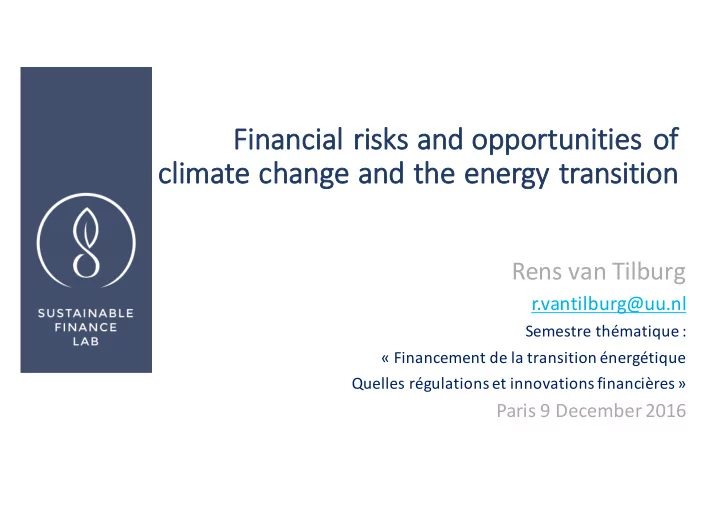

Fi Financial risks an and op oppor ortunities es of of cl climate ch change and the energy transition Rens van Tilburg r.vantilburg@uu.nl Semestre thématique : « Financement de la transition énergétique Quelles régulations et innovations financières » Paris 9 December 2016
Overview of the presentation • How is the energy transition relevant for the financial sector? • What is its impact for the European financial system? • What can regulators and supervisors do?
Source: Vuuren and Faber (2009)
Climate imbalance (stress) Physical risk Transition risk 2100 new equilibrium with higher average temperature 2 degree 5 degree
Transition risk: Unburnable carbon
Financial impact carbon bubble Direct effects Energy commodities • Market value of oil, gas and coal mining firms • Credit risk of oil, gas and coal mining firms • ? Indirect effects Electricity producers, energy-intensive industries • Other business sectors • Governments of resource-rich countries •
The stress test Pension funds Exposures to high-carbon assets Banks Insurers Commodities Potential shocks Securities Loans Feedback % assets Estimated losses loops % capital Economy Investors Markets Propagation of shocks Firms Households
What we looked at Exposures to high-carbon assets (gas, oil and coal mining companies) Pension funds 23 large funds, from 8 EU countries • >€ 1,200 billion assets (24% of EU total) • Banks 20 largest banks, from 8 EU countries • >€ 22,000 billion assets (62% of EU total) • Insurance companies Aggregated data •
Exposure European financial institutions to fossil fuel firms (in € bn) Equity Debt Total As % total assets Banks 98 365 a) 463 1.4 Pension funds 196 b) 60 256 5.0 Insurance 109 233 342 4.0 Total 403 658 1.061
The shock, price developments in the low carbon break through scenario Commodities -50% Equities -60% Bonds -30% Term & project loans -30% Credit facilities -20%
Low-Carbon Breakthrough Scenario Quick and definite transition to low-carbon • economy Consequences Sudden loss on high-carbon assets • Estimated total losses for EU banks (0.4% assets), • pension funds (3%) and insurance companies (2%) €350-400 billion This is unlikely to trigger harmful feedback loops •
Uncertain Transition à Larger losses Scenario Emissions remain eventually within carbon budget • Transition path is initially slow and uncertain • Consequences Ongoing capital expenditures € 500 billion/year • Increasing stranded assets and losses • Uncertainty about valuation of assets •
Carbon Renaissance à Most harmful Scenario Strongly increasing demand for fossil fuels • Ineffective climate policies • Consequences Uncontrollable climate change (more floods, • draughts, extreme storms, etc.) Serious harm to global economy • Larger losses on broad range of assets •
Conclusions • Serious money at stake • Specific financial institutions could encounter serious problems • No financial stability argument against effective climate policy now • The longer we wait , the more expensive it gets (and the bigger the financial stability risk)
� � ���� �� ����������� ����� ��������� ���� ������ ���� ������� ������ ���������� ������ ���� ����������������������������������������������������������������������������������������� ���������������������������������������������������������������������������������������� ����������������������������������������������������������������������������������� ��������� ��� ������ ���������� ��� ���� ����������� ��� �������������� ��� ����������������� Macroprudential policy strategy ������������ ���� ��������� ����� ������ ������������� ����������� ����� �������� ���� ������� ������������������������� Figure 2 Macro-prudential policy strategy Guided � discretion Intermediate � Instruments Indicators objectives Financial � stability (ultimate � objective) � Source: ESRB (2014) ���� ������������������������������������������������������������������������������� ��������������������������������������������������������������������������������������� �������������������������������������������������������������������������������������� ��� ����� ������ �������� ����� ���� ����������� ���������� ���� ������������ ������� ������ ���� ���������������������������������������������������������������������������������� �������������������������������������������������������������������������������������� ��������������������������������������������������������������������������������� �������������������������������������������������������������������������� � � � � � � � � � � ��
Financial crisis sensitivity of asset classes Criteria Housing Shipping Dotcom Carbon Long-lived ✓ ✓ ✗ ✓ Capital intensive ✓ ✓ ✓ ✓ Economic share ✓ ✗ ✓ ✓ Debt-financed ✓ ✓ ✗ ✓ Crisis prone Yes No No Yes
External environmental costs Source: KPMG (2012)
Cyclical pillar Intermediate target Excessive credit growth for carbon intensive and dependent economic activities Indicators Carbon intensity and dependency credit Key instruments Counter Capital instruments, higher risk ‘Carbon cap’ cyclical weights for: - exclusion list capital - carbon intensive and dependent - maximum debt finance for buffer sectors (transport, mining, energy) carbon intensive/ dependent - carbon intensive and dependent sectors and companies companies within these sectors
Structural pillar Intermediate Exposure concentration to carbon Misaligned incentives target intensive and dependent assets Indicators Net exposure Carbon intensity and dependency of SIFIs Key instruments Large exposures restrictions SIFI capital surcharge
Impact Regulators and supervisors • materialityacknowledged • asking questions/ demandingtransparency (French Art 173) Financial institutions • setting goals for exposure and engagement • but still largely without real risk assessment
An identified yet unassessed risk Source: CISL (2016)
Way forward Develop environmental risk scenarios , including indirect affects , for different asset classes: • to do carbon stress tests . • used to calibrate the macroprudentialinstruments; Make this an integral part of macroprudentialsupervision also in the IMF Financial Sector Assessment Program ( FSAP ) and the FSB peer review assessments of the macro prudential policy framework.
Looking ahead through the rear view mirror
Merci! Further reading: “The price of doing too little too late” 2014, with Weyzig et al. “Financial risks and opportunities in the time of climate change” 2016, with Schoenmaker. Rens van Tilburg r.vantilburg@uu.nl
Recommend
More recommend